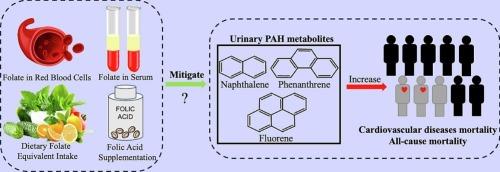前瞻性人群中多环芳烃暴露与死亡率之间的关系以及叶酸生物标志物对其影响的修正
IF 8.2
Q1 ENVIRONMENTAL SCIENCES
引用次数: 0
摘要
在普通人群中,叶酸生物标志物与多环芳烃(PAHs)的关系仍不明确。因此,本研究旨在探讨叶酸生物标志物是否与多环芳烃有关,以及叶酸生物标志物能否减轻多环芳烃对健康造成的不良影响。这项前瞻性队列研究纳入了来自美国国家健康与营养调查(NHANES)的 11,246 名参与者,在平均 9.1 年的随访中记录了 1,303 例死亡病例。多变量线性回归模型用于研究尿液中单个多环芳烃与叶酸生物标志物之间的关系。多变量 Cox 比例危险回归模型用于计算多环芳烃和叶酸生物标志物与心血管疾病死亡率和全因死亡率之间的危险比和 95 % CI。我们发现红细胞(RBC)中的叶酸与尿液中的 1-羟基菲呈负相关(叶酸增加 2-7 倍的百分比变化为 -4.19 %,95 % CI -5.80 %至-2.56 %CI)、2-羟基芴(-6.66 %,-7.84 %至-5.49 %)、3-羟基芴(-5.78 %,-6.77 %至-4.78 %))和 1-羟基萘(-2.75 %,-3.48 %至-2.01 %)。血清叶酸与多环芳烃之间的相关性与红细胞叶酸的相关性一致,血清叶酸与 2-羟基萘之间也存在负相关(-4.10 %,-5.26 % 至 -2.94 %)。在红细胞中叶酸水平最低的四分位数中,2-羟基芴、3-羟基芴、1-羟基萘和 2-羟基萘与心血管疾病死亡风险升高密切相关[HRs (95 % CI) >1]。当红细胞中的叶酸水平上升到第三和第四四分位数时,这些关联就不复存在了[HRs (95 % CI) <1,P-交互作用<0.05]。尿 PAHs 与心血管疾病死亡率之间的正相关也随着血清叶酸水平的升高而消失[HRs (95 % CI) <1,P-交互作用<0.05]。此外,我们还发现红细胞和血清中较高水平的叶酸可大大降低 1-羟基萘对全因死亡率的不利影响。日常膳食叶酸和叶酸补充剂的摄入量也验证了一致的结果。我们的研究强调了尿多环芳烃与叶酸之间的密切负相关关系。此外,我们还发现叶酸可有效降低多环芳烃导致的死亡率,尽管我们并未观察到叶酸可直接降低死亡率。本文章由计算机程序翻译,如有差异,请以英文原文为准。

Associations of polycyclic aromatic hydrocarbons exposure with mortality and effect modification by folate biomarkers in a prospective population
The associations of folate biomarkers and polycyclic aromatic hydrocarbons (PAHs) in the general population remain unclear. Therefore, this study aimed to examine whether folate biomarkers are associated with PAHs, and whether folate biomarkers can mitigate adverse health outcome caused by PAHs. This prospective cohort study included 11,246 participants from the National Health and Nutrition Examination Survey (NHANES), which documented 1,303 deaths over a mean follow-up of 9.1 years. Multivariable linear regression models were used to examine the relationship between urinary individual PAHs and folate biomarkers. Multivariable Cox proportional hazards regression models were used to calculate hazard ratios and 95 % CIs for the associations of PAHs and folate biomarkers with CVDs mortality and all-cause mortality. We found negative associations between folate in red blood cells (RBC) and urinary 1-Hydroxyphenanthrene (percentage change for a 2·7 fold-increase in folate −4.19 %, 95 % CI -5.80 % to −2.56 %CI), 2-Hydroxyfluorene (−6.66 %, −7.84 % to −5.49 %), 3-Hydroxyfluorene (−5.78 %, −6.77 % to −4.78 %)) and 1-Hydroxynapthalene (−2.75 %, −3.48 % to −2.01 %). The associations between serum folate and PAHs were consistent with those observed for RBC folate, and negative associations were also found between serum folate and 2-Hydroxynapthalene (−4.10 %, −5.26 % to −2.94 %). Within the lowest quartile of folate levels in RBC, there are strong associations of 2-Hydroxyfluorene, 3-Hydroxyfluorene, 1-Hydroxynapthalene, and 2-Hydroxynapthalene with elevated risk of CVDs mortality [HRs (95 % CI) >1]. As folate levels in RBC increase to the third and fourth quartiles, these associations no longer exist [HRs (95 % CI) <1, P-interaction<0.05]. The positive associations between urinary PAHs and CVDs mortality are also eliminated as serum folate levels rise [HRs (95 % CI) <1, P-interaction<0.05]. Furthermore, we also found higher levels of folate in both RBC and serum can greatly reduce the adverse impact of 1-Hydroxynapthalene on all-cause mortality. Consistent results were also validated in daily dietary folate and the folic acid supplement intake. Our study highlighted a robust negative relationship between urinary PAHs and folate. Additionally, folate was found to effectively mitigate mortality caused by PAHs, although we did not observe a direct reduction in mortality attributable to folate.
求助全文
通过发布文献求助,成功后即可免费获取论文全文。
去求助

 求助内容:
求助内容: 应助结果提醒方式:
应助结果提醒方式:


